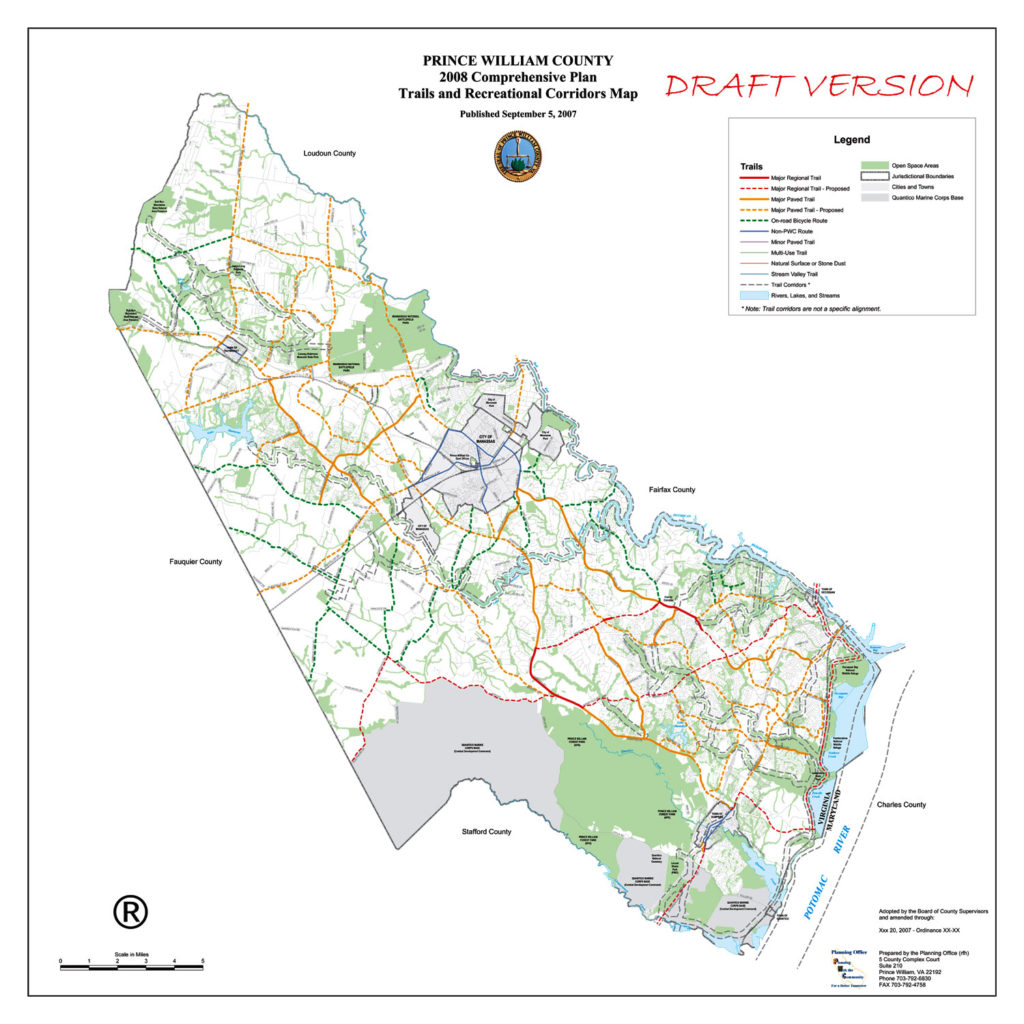
1) Establish Citizen Transportation Advisory Commissions for Prince William County, Manassas, and Manassas Park.
2) Provide Meaningful and Robust Public Participation Processes for the Coming Comprehensive Plan Updates for the County and Cities.
3) Expand and Enhance Public Transportation as an Effective Travel Choice:
a) Add midday, evening, and reverse-commute VRE trips, possibly as shortened runs to/from Alexandria and/or Springfield/Franconia.
b) Add local and commuter bus service along Rte 28 and Sudley Rd, ideally in dedicated lanes.
c) Extend Richmond Hwy BRT south through Prince William County along the Rte 1 corridor to Quantico.
4) Build Complete Streets, especially a Primary Bikeway Network that Crosses Major Barriers (e.g., rivers, freeways, land parcels):
a) Build a continuous “I-66 Trail”, largely along Balls Ford Rd and across Bull Run into Fairfax County.
b) Build a quality bike/ped crossing of I-66 at or near Sudley Rd/Bus 234. In short term, ensure space for paths beneath all new I-66 overpasses of Sudley Rd.
c) Retrofit quality bike/ped crossings of I-95, especially at/near Prince Wm Pkwy/Horner Rd and at/near Dale Blvd/Opitz Blvd, but also at/near Rte 123, 234, & Joplin Rd.
d) Complete a continuous trail along Rte 234, from Rte 1 to I-66, including the totally missing segment between Brentsville Rd and I-66.
e) Include quality bike/ped access along and across Flat Branch and Bull Run in the proposed Godwin Dr Extension (Rte 28 environmental assessment).
f) Improve US Bike Route 1, a Maine-to Florida bikeway: Retrofit paved shoulders along Aden Rd (Joplin Rd to Fleetwood Dr) and Fleetwood Dr (Aden Rd to Fauquier line), fix the Hoadly Rd bike lanes, and sign all of USBR1 in PWC. Plan and create a paved shared-use path along the perimeter of Quantico Marine Corps Base as a long-term project.
g) Improve bike/ped crossings of Bull Run and the Occoquan River, including at Old Centreville Rd/Ordway Rd, Rte 28, Yates Ford Rd, I-66 Trail (connect Balls Ford Rd to Bull Run Dr), and Rte 1.
h) Improve bike/ped access along the Rte 29 corridor (Bull Run to Fauquier line).
i) Establish continuous ped/bike access along Old Bridge Rd.
j) Plan and develop a bikeway and trail network in Manassas Park.
5) Develop Livable, Walkable, and Vibrant Transit-Oriented Communities:
a) Plan to revive aging suburban retail corridors and malls for higher-density, mixed-use, bus-transit-oriented redevelopment (e.g., Manassas Mall and the Sudley Rd corridor, Rte 28 in Yorkshire, Rte 1, Dale Blvd, Old Bridge Rd).
b) Remove or scale back all or part of numerous proposed road widenings from the Comprehensive Plan, including Brady’s Hill Rd, Carver Rd, Catharpin Rd, Dale Blvd, Dumfries Rd, Farm Creek Dr, Featherstone Rd, Gideon Dr, Godwin Dr Extension, Gordon Blvd, Groveton Rd, Gum Springs Rd, Horner Rd, Lucasville Rd, Manassas Battlefield Bypass, Neabsco Rd, Old Centreville Rd, PW Pkwy, Signal Hill Rd, Station Rd, Sudley Manor Dr, Sudley Rd, Rte 15, Rte 29, Rte 55, and Wellington Rd.
c) Innovation Town Center: Plan and develop a robust pedestrian and bicycle network, including a high-quality connection to the north side of the expanded Broad Run VRE Station.
6) Operate a Vibrant Safe Routes to School Program:
a) All new public schools, including the 13th high school, should be walkable and bikeable and include quality bicycle parking accommodations.
7) Make Walking and Bicycling Safer:
a) Improve pedestrian crossings of multilane arterials (e.g., add missing pedestrian crossing signals, Leading Pedestrian Intervals, conspicuously marked crosswalks, sidewalk bulb outs, and/or streetlights; remove Right-Turn-Only Lanes).
b) Retrofit missing sidewalks along arterial roadways and on walk routes to schools and transit.
c) Provide a signed detour when pedestrian or bicycle facilities are closed for construction or maintenance activities.
8) Build a Comprehensive Recreational Trails Network:
a) Complete the East Coast Greenway/Potomac Heritage National Scenic Trail shared-use path through PWC, generally between Rte 1 and the Potomac River.
9) Improve VRE Bicycle Access:
a) Provide covered bicycle parking and rental bicycle storage lockers at every VRE station in Prince William County, Manassas, and Manassas Park.
b) Improve bike/ped connections to VRE stations from all directions, including the expanded Broad Run station (including the Broad Run Trail), to improve bike/ped access to VRE from Bristow, the Landing at Cannon Branch, and Innovation Town Center.
c) Expand VRE bike-on-rail access (long capped at 34 bikes on 17 daily trains).
10) Provide Ubiquitous, Quality Bicycle Parking Accommodations.
